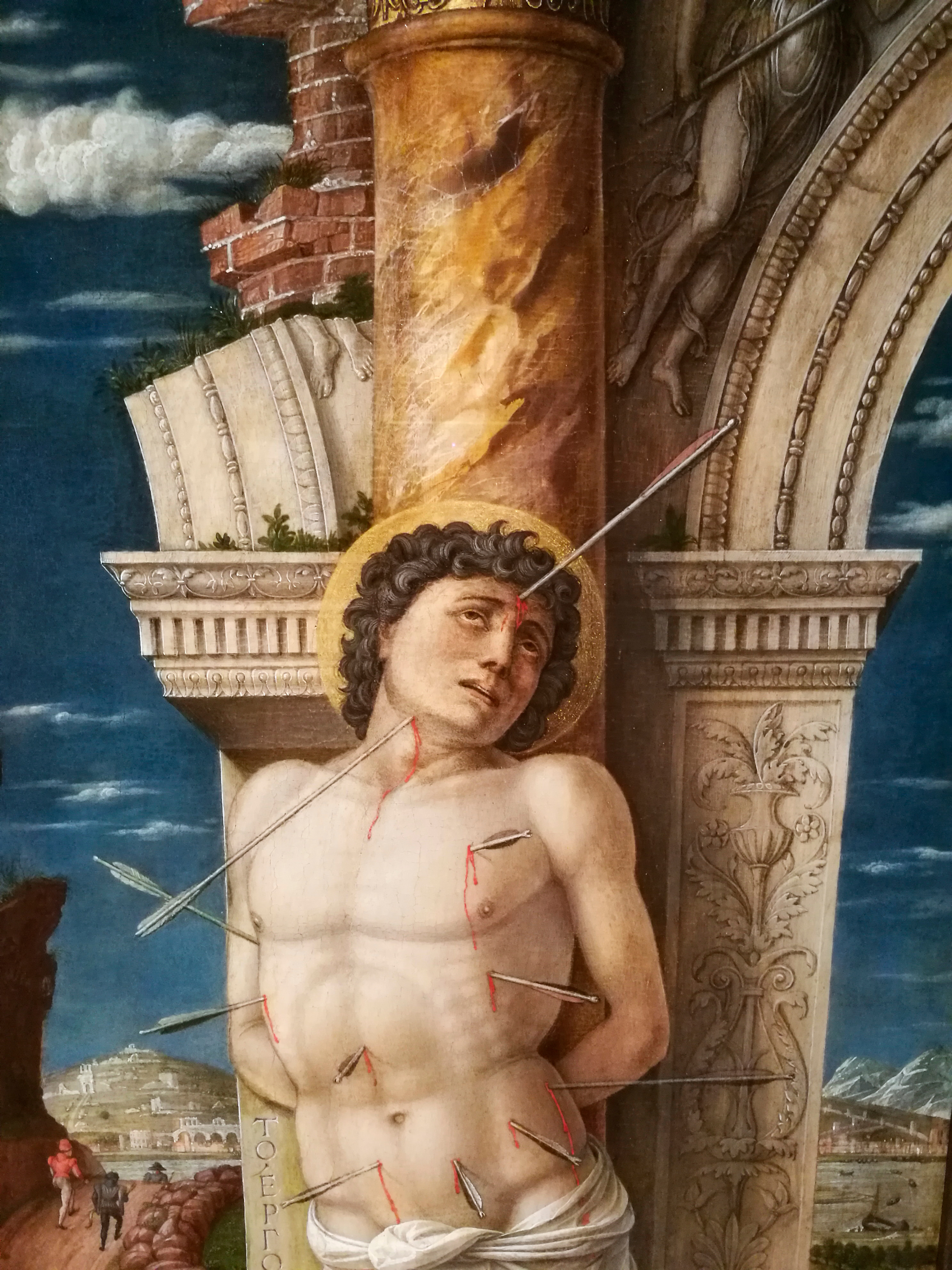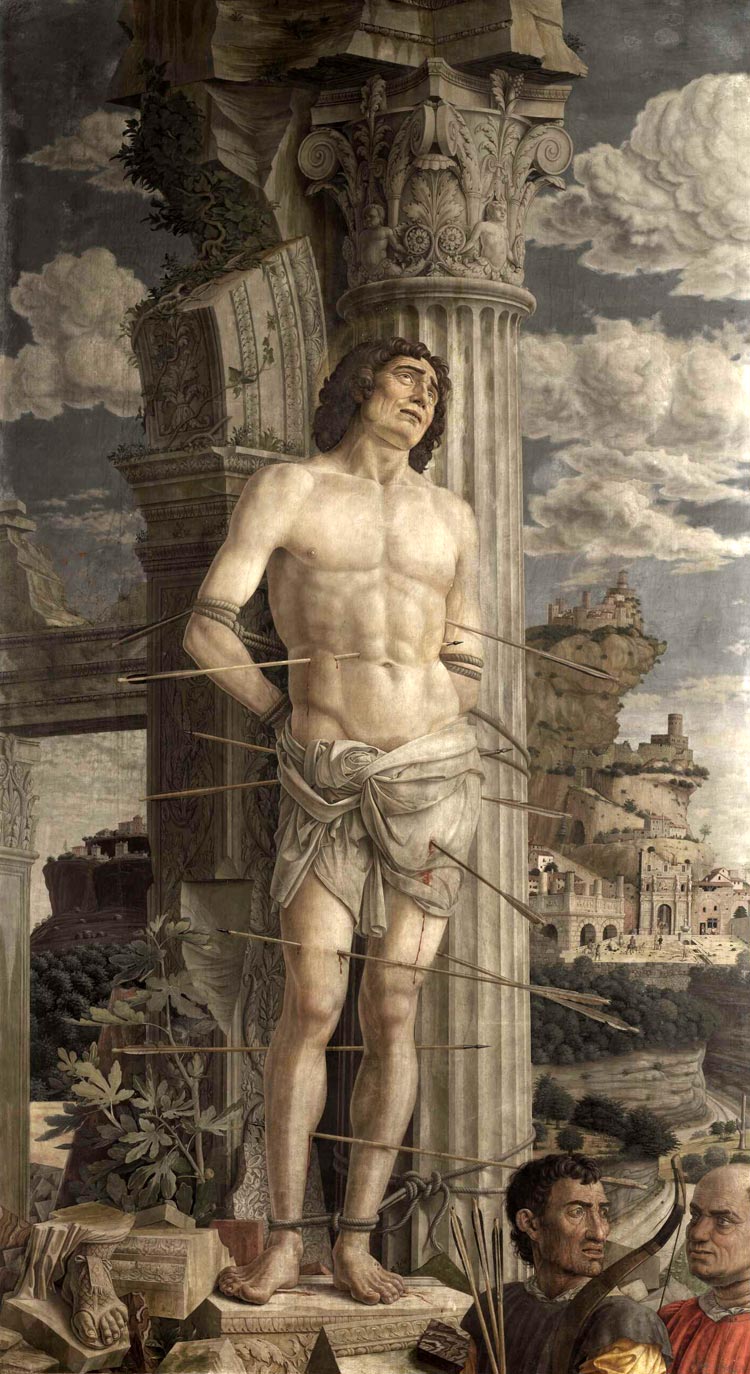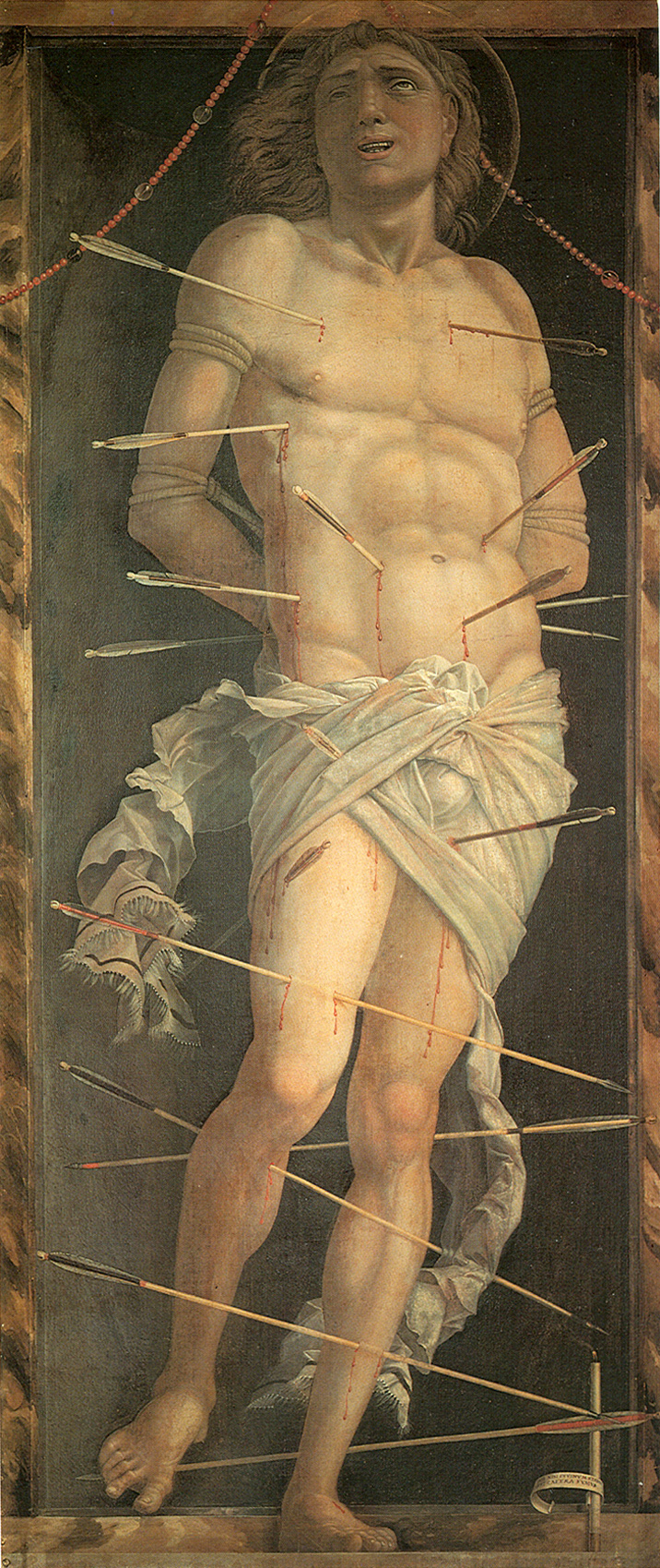Mantegna’s Saint Sebastian: three masterpieces compared

Saint Sebastian, the Christian martyr and protector against the plague, has been the subject of artistic inspiration for numerous artists over the centuries. Among the most famous representations are three masterpieces by Andrea Mantegna, created at different stages of his artistic career.
In this post, I will take a closer look at the three versions of Mantegna’s Saint Sebastian preserved in Vienna, Paris and Venice respectively, to discover their characteristics and differences.
Mantegna’s Saint Sebastian: three masterpieces compared

DESCRIPTION OF THE SAINT SEBASTIAN EXHIBITED AT THE KUNSTHISTORICHES IN VIENNA
Mantegna’s Saint Sebastian in Vienna is tied to a column that seems to be part of a sequence of arches.The saint is raised on a fragment of stone and one can glimpse the tufts of grass that have grown in the recesses of this ancient architecture, whose decadence contrasts with its rich ornamentation.
Behind San Sebastiano a landscape opens up that reminds one of Jerusalem, but which in reality is just a collection of buildings, triumphal arches, all ancient inspiration. It almost looks like an ideal city built by assembling architectural models from some travel notebook.
Mantegna’s signature is located on the pillar to the left of St. Sebastian, where it reads in Greek letters: TO ERGON TOU ANDREOU (work of Andrea).
WHY MANTEGNA’S ST. SEBASTIAN IS IN VIENNA
Mantegna’s Saint Sebastian is now part of the collection of works in the Kunsthistorisches Museum in Vienna and came from the collection of Archduke Leopold Wilhelm. The painting was inventoried as early as 1659 and we know that the work was executed by Mantegna in 1459, at the time when he was finishing his stay in Padua.

DESCRIPTION OF THE SAINT SEBASTIAN EXHIBITED AT THE LOUVRE
Mantegna’s Saint Sebastian, preserved and exhibited alongside the great masterpieces and works of the Louvre Museum, is tied to an architectural element, while at his feet are fragments of ancient sculptures and architecture.
The background suggests that the saint is standing in a place of rocky overhangs, where a castle once stood and where there are now only ruins.
Saint Sebastian is pierced by countless arrows and in the lower part of the painting the archer and one of his companions can be glimpsed.
WHY MANTEGNA’S ST. SEBASTIAN IS IN PARIS
Mantegna’s Saint Sebastian arrived in the Louvre from the church ofNotre-Dame ad Aigueperse. The original provenance was almost certainly a donation by Chiara Gonzaga, who had married in 1481 and had gone to live near the church, in the residence of Count Gilbert de Bourbon Montpensier.
Thanks to this marriage and the fact that Chiara Gonzaga was a passionate collector, the castle and the church acquired a large number of Italian works of art.
Mantegna’s Saint Sebastian was probably an altarpiece that had been commissioned especially for the residence where Chiara Gonzaga lived. The work is dated between 1482 and 1485.

San Sebastiano di Mantegna
DESCRIPTION OF THE SAINT SEBASTIAN EXHIBITED AT THE CA’ D’ORO
Mantegna’s Saint Sebastian exhibited at the Ca’ d’Oro in Venice is one of the artist’s latest works. The saint is placed in front of a circular niche from which he seems to emerge. His left foot rests on a plane outside the niche, while his right foot is raised and caught in the moment in which he moves.
It is precisely this movement that makes the St. Sebastian in Venice different from the one in Vienna and Paris, made even more evident by the dynamism expressed in the saint’s expression of pain as he opens his mouth, but also by the wind that moves the cloth around his waist.
However, Mantegna’s St. Sebastian exhibited at the Ca’ d’Oro presents some anatomical uncertainties, which may be due to the fact that the artist was unable to complete the painting, as he died, and it was some interventions by his pupils that completed the work interrupted by the master.
The work is dated between 1504 and 1506.
WHY MANTEGNA’S SAN SEBASTIANO IS IN VENICE
Mantegna’s Saint Sebastian in Venice is almost certainly the work that was found in the artist’s studio in Mantua after his death in September 1506.
Scholars claim that the painting was made for Bishop Ludovico Gonzaga but entered the collection of Pietro Bembo upon the artist’s death.
It is not surprising that the work was destined for a Gonzaga as Mantegna was the main artist of the Mantuan court. Indeed, let us not forget that he was the author of the Bridal Chamber, the masterpiece of the Ducal Palace in Mantua.
ST. SEBASTIAN BY MANTEGNA: THREE MASTERPIECES COMPARED
Mantegna’s Saint Sebastian in the Kunsthistorisches Museum in Vienna is a masterpiece of elegance and refinement. Mantegna emphasises the figure of Saint Sebastian, placing it in the foreground and wrapping it in realistic drapery.
The musculature of the body is rendered with great precision and the saint’s face conveys a serene determination to endure his martyrdom. The attention to anatomical details and the realistic rendering of the scene give this painting a sense of strength and intimacy.
The Saint Sebastian that can be admired by purchasing the entrance ticket to the Louvre is a different interpretation of the martyr.
In this version, Mantegna chooses a more compact and collected composition. The Saint is depicted in profile and emerges from the dark background, creating a strong contrast that intensifies the drama of the scene.
The detailed rendering of details, such as the arrows piercing the flesh and the tension in the muscles, helps to create an atmosphere of suffering and sacrifice.
Finally, the Saint Sebastian in the Giorgio Franchetti Gallery at the Ca’ d’Oro in Venice seems more experimental.
Mantegna abandons the classical composition, eliminates the background and depicts the martyr in a more dynamic pose. The artist also emphasises symbolic elements but anatomical uncertainties, due to the fact that Mantegna died before completing the painting, make this work the least successful of the three.
Despite their differences, the three versions of Saint Sebastian by Mantegna share a central theme: the martyrdom of the saint.
Each work offers a unique view of this event, showing the different facets of Mantegna’s talent and creativity throughout his career. From the elegance of Vienna to the drama of Paris and the expressiveness of Venice, these works demonstrate Mantegna’s ability to represent the theme of the martyrdom of Saint Sebastian through different points of view.
Follow me on:
About me
In this blog, I don't explain the history of art — I tell the stories that art itself tells.


